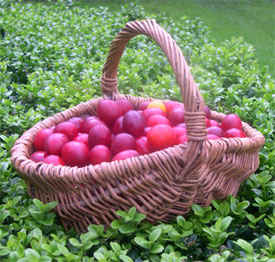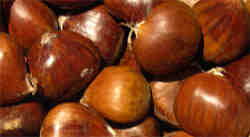Cottage Smallholder Plum Chutney or Damson Chutney
Posted by Fiona Nevile in Chutney and Pickles, Jam Jelly and Preserves | 222 comments
a wicker basket full of wild plums
This chutney recipe works well with plums, wild plums or damsons. It does not need months to mature and keeps well
I had some spare time today so finally retrieved the stock pot from Danny, swooshed it out with bicarbonate of soda to get rid of the taint of clove chutney (see Tricks and Tips below) and found the plum chutney recipe from Anne Mary’s old cook book. This was going to be the base of our own Cottage Smallholder Chutney.
I had collected three pounds of windfall wild plums yesterday and simmered them last night for 20 minutes in 75 ml of white wine vinegar. This is Delia’s canny trick to avoid stoning fresh plums for chutney (use some of the vinegar that you are going to use for your brew). This morning, grabbing a handful at a time, it was easy to find the stones and remove them (our wild plum stones are tiny, barely a centimetre long).
At breakfast we studied Anne Mary’s recipe and decided how we would change it to create a plum chutney that we would be proud of. Danny had to go to London so pinpointed his essential ingredients for our chutney – balsamic vinegar and juniper berries. As I was the one who ruined the last “Let’s make our own” batch with too many cloves, I decided that our chutney was definitely going to work this time.
There was a clove shaped crisis of confidence. And consequently the alterations that I made today were incrementally smalll. This meant hours of tasting, comparisons and retasting, until I felt quite queasy from ingesting so much chutney. (At least a jar without lunch). It has now simmered (tiny bubbles barely breaking the surface) for five hours. When you draw a wooden spoon through the chutney, it is thick enough to see where you have been. It is finally done, and approved for release. We have made a great plum chutney, extra fruity and piquant.
Danny returned exhausted from London and sniffed the aroma as he walked into the kitchen. There was a long silence as he grabbed a spoon and rushed to the stock pot for a taste. His response was positive. Our recipe is below..
Our latest Plum and Tamarind Chutney recipe is here.
Tricks and Tips:
- How do I get rid of tainted smells in pots?
If your cooking pot or container is tainted with the smell of the last resident (curry, tomato sauce etc). Sprinkle with a good tablespoon of bicarbonate of soda into it and add a good splosh of hot water. Rub the solution over all surfaces and leave for two minutes. Rinse well in cold water.
- How do I sterilise jars and lids?
The sterilising method that we use is simple. Just before making the jam, I quickly wash and rinse the jars and place them upside down in a cold oven. Set the temperature to 160c/140c for fan assisted. When the oven has reached the right temperature I turn off the heat. The jars will stay warm for quite a while. I only use plastic lined lids for preserves as the all-metal lids can go rusty. I boil these for five minutes in water to sterilise them. If I use Le Parfait jars, I do the same with the rubber rings.
| Cottage Smallholder Plum Chutney or Damson Chutney |
- 3lbs/1350g wild plums/damsons/eating plums
- 1lb/450g of apples (cored but not skinned). Chopped fine. Cooking apples are best but eating apples would do at a pinch.
- 1 lb/450g onions chopped fine
- 10.5 ozs/300g dried apricots (chopped at least into eight)
- 7 ozs/200g dried raisins (chopped into four)
- Half lb-1lb/225g-450g of soft brown sugar, depending on how sweet your wild plums/damsons/eating plums are. We’d usehalf a lb of sugar for eating plums but used 1lb for this batch as we were using wild plums (these are very tart like damsons).
- 2 large cloves of garlic chopped fine
- Half tsp of cayenne pepper
- 2 tsp of salt
- 1 tsp of allspice powder
- 1 tsp cinnamon powder
- 1 tsp ground ginger
- 1and a half pints/750 ml of white wine vinegar
- 1 small hot chilli
- 2 tsp of balsamic vinegar
- 5 juniper berries
- 10 black peppercorns
- Stone the plums and if big enough cut into slices.
- Chop the apples, onions, raisins and apricots.
- Place all ingredients in a large heavy bottomed saucepan and bring slowly to a gentle boil. Turn the heat down immediately and simmer very gently (tiny bubbles just breaking the surface on the lowest heat) for at least five hours until the mixture has broken down and thickens.
- Stir from time to time and more towards the end. If your simmering point is higher than ours, your chutney will be ready sooner. Take a peek every half hour or so. The chutney will thicken as it cools.
- When ready pour into sterilised jars and cover with plastic lined metal lids (how do I sterilise jars and lids? See Tips and Tricks above).
Leave a reply






Hi Vivienne,
Sterilising jars in the microwave is a great tip and also the knob of butter at the fast boil stage for jam. Thanks for sharing.
Just about to make your chutney since I have made loads of damson jam. I sterilise my jars in the microwave. I put in about 8 jars on high for 4-5 mins which gives good hot jars and a good seal when lids are put on immediately.
Another tip that my mum taught me over 40 years ago is to put a knob of butter into jam at the fast boil stage. This reduces the amount of scum that you have to skim off- in some cases there will be none at all.
Hi Marie,
I’d leave it for a month before using it just to let the flavours develop a bit longer. It keeps well and gradually improves with age.
Well the chutney has finished cooking and it tastes and smells good. i put in double the amount of balsamic vinegar ( by mistake) and it tasted too strong and balsamic-icky so I added a pot of plum jam that I made yesterday that was too runny and it tastes very good now. How long must it be stored before its eaten. Thanks for the recipe, Maire
Hi Gareth,
Put the chutney into warm sterilised jars when it is ready and still hot. Don’t allow it to cool. Remember to use screw topped lids as the vinegar will evaporate thhrough jam pot covers.
Sorry, another question.
You say: ‘The chutney will thicken as it cools’ and ‘When ready pour into sterilised jars’
So, do I allow the chutney to cool before bottling or do I bottle warm as I understand you do with jams?
Good adaptation, no frights or broken teeth!
Gotcha. Will do, thanks for the instant response.
SWMBO (She who must be obeyed) doesn’t like anything unexpected in her food, so I’ve put the spices and cracked plum stones in an old stocking to allow for easy removal. That’s my only adaptation. Am I right?
I’ll be back with an update.
G.
Hi Gareth,
Simmer the pot uncovered and very, very gently. Hope it turns out well!
Hi,
I have the pot on the stove right NOW with this recipe religiously followed. Many thanks, it looks a corker.
Tell me please, when I’ve brought the mixture to the boil, do I simmer covered or uncovered?
Thanks in advance,
Gareth